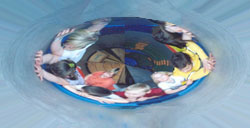Evaluation of motor coordination in early school aged children
Motor coordination ability development has constituted a popular field of in the last decade, as it provides important information about children’s developmental level. The purpose of this study was to evaluate the level of motor coordination in early school age children. The sample consisted of 150 students (72 boys and 78 girls) of ages ranging from 69 to 99 months (Μ=83.75, SD=7.43), who attended the organized educational program of their school and did not participate in any exercising program. For the evaluation of motor coordination Koerperkoordinationstest fuer Kindern, KTK, was used. The test is considered to be one of the most reliable (r=.90) and is comprises of four individual tests that measure: a) balance capacity, b) one- leg obstacle surmounting, c) side jump and d) side locomotion and object replacement. The Two-Way Analysis of Variance did not present any statistically significant interaction of age and sex in any of the individual tests.
Evaluation of motor coordination in early school aged children Read More »






